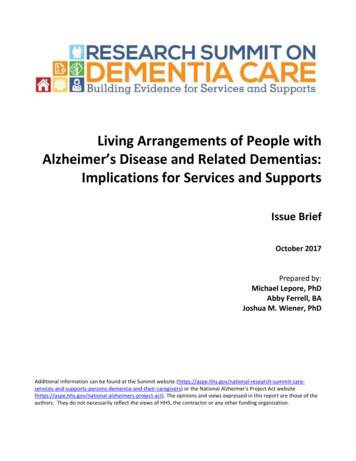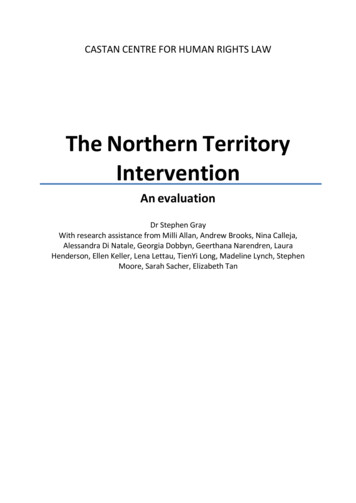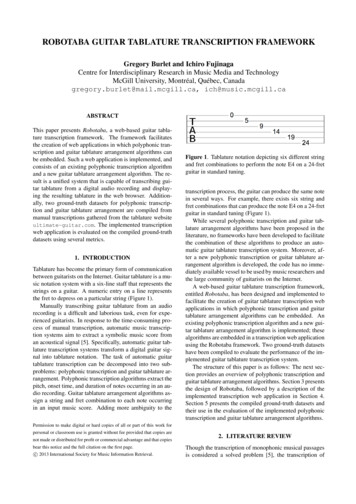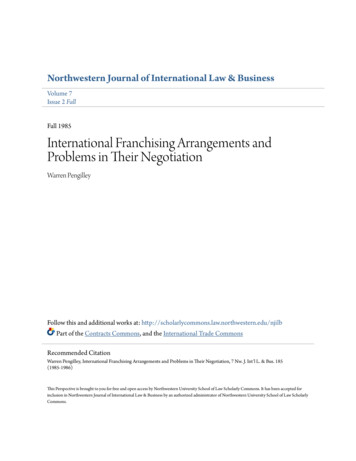
Transcription
Living Arrangements of People withAlzheimer’s Disease and Related Dementias:Implications for Services and SupportsIssue BriefOctober 2017Prepared by:Michael Lepore, PhDAbby Ferrell, BAJoshua M. Wiener, PhDAdditional information can be found at the Summit website caregivers) or the National Alzheimer's Project Act roject-act). The opinions and views expressed in this report are those of theauthors. They do not necessarily reflect the views of HHS, the contractor or any other funding organization.
October 11, 2017Living Arrangements of People withAlzheimer’s Disease and RelatedDementias: Implications for Servicesand SupportsIssue BriefResearch Summit on Dementia Care:Building Evidence for Services and SupportsPrepared forRohini Khillan, MPHOffice of the Assistant Secretary for Planning and EvaluationDisability, Aging, and Long-Term Care Policy200 Independence Avenue, SWWashington, DC 20201Prepared byMichael Lepore, PhDAbby Ferrell, BAJoshua M. Wiener, PhDRTI International701 13th Street, NWSuite 750Washington, DC 20005RTI Project Number 0215288.002.000.001
ContentsSectionPageIntroduction .1Home-Based Living Arrangements for PWD .1Long-Term Services and Supports Use in Home-Based Settings . 3Quality of Care in Home-Based Settings . 4Hospitalizations and Emergency Department Use in Home-Based Settings . 4Costs in Home-Based Settings . 4End-of-Life Care in Home-Based Settings . 5Congregate Community-Based Living Arrangements for PWD .5Financing in RCSs . 6Quality in RCSs . 6Hospitalizations and ED Use in RCSs . 6Costs in RCSs . 7End-of-Life Care in RCSs. 7Nursing Homes .7Special Care Units in Nursing Homes . 8Quality of Care in Nursing Homes . 9Hospitalizations and ED Use among Nursing Home Residents . 9Costs. 10End-of-Life Care . 10Other Living Arrangements .11Veteran-Centered Settings . 11Unlicensed Care Homes. 11Prisons. 11Homelessness . 12Conclusion .12References .14iii
TablesNumber1PageEstimated Distribution of People with Dementia by Living Arrangement, 2017.1iv
IntroductionPeople with Alzheimer’s disease and other dementias (PWD) live in various settings thataffect the quality of their lives and their health and well-being. This issue brief provides anoverview of where PWD live and reviews use of services, quality of care, hospital andemergency department (ED) use, costs of care for PWD, and end-of-life care in various livingarrangements. The issue brief concludes with some possible research agendas.In 2017, there were an estimated 5.5 million PWD in the United States (Alzheimer’sAssociation, 2017). As shown in Table 1, PWD live at home, with caregivers and alone; inresidential care settings (RCSs) such as assisted living; and in nursing homes. In addition, PWDlive in veteran-specific settings such as State Veteran Homes, prisons, mental hospitals, andunlicensed care homes. Most people with dementia live in the community, but nearly a fifth livein either RCSs or nursing homes. Of people living in the community, most live with others, but asignificant portion live alone—indeed, more than the total PWD who live in RCSs or nursinghomes.Table 1. Estimated Distribution of People with Dementia by Living Arrangement, 2017Total livingin thecommunityLiving in thecommunitywith othersLiving alonein thecommunityEstimated numberof people ercent of peoplewith dementia815724613100PrevalenceLiving inresidentialcare settingsLiving innursinghomesTotalSource: Authors’ estimates based on Alzheimer’s Association, 2017; Harris-Kojetin et al., 2016; and Okura et al.,2011. People living in the community were calculated by subtracting number of people living in RCSs andnursing homes. People living alone were calculated as 30 percent of people living in the community.Home-Based Living Arrangements for PWDHome-based living arrangements for PWD include single-family homes, apartments, andother private residences (e.g., condominiums, mobile homes). The majority of PWD, like mostolder people, live in their own homes. Although estimates vary, the National Health and AgingTrends Study (NHATS) data indicate that 9.7 percent of the U.S. population age 65 and olderwho were not in nursing homes had probable dementia in 2011 (Kasper, Freedman & Spillman,2014).Most PWD who live at home reside with others, typically spouses or other familymembers.1
People with dementia generally need more support from their caregivers than thosewith other illnesses (Pinquart & Sorensen, 2003; Spector & Kemper, 1994). Inaddition to arranging health care visits, participating in medical decision making, andcoordinating support services, caregivers of people with dementia must take steps tokeep the person safe and to address the behavioral and psychological symptomsexperienced by 80–90 percent of people with dementia (Black et al., 2013; Lyketsoset al., 2002). Dementia caregivers also experience challenges in performing nursingtasks and helping the person with dementia with activities of daily living, such aseating, bathing, and meal preparation (National Alliance for Caregiving [NAC]/[AARP], 2015).The overwhelming majority of help provided to people with dementia comes fromfamily members, friends, or other unpaid caregivers (Schulz & Martire, 2004). Datafrom NHATS suggest that of the approximately 7.7 million older adults who receivedcare from unpaid caregivers in 2011, 45.5 percent (approximately 3.5 million) werepeople with Alzheimer’s disease and other dementias) (Wolff, Spillman, Freedman,& Kasper, 2016).More than half of dementia caregivers provide more than 21 hours of care per week(NAC/AARP, 2015). About two-thirds of caregivers are women (Kasper, Freedman,& Spillman, 2014). The same study reports that about one-third of dementiacaregivers are 65 or older, about two-thirds live with the person with dementia, andone-quarter are “sandwich” caregivers who take care of both a parent and childrenunder 18 (Alzheimer’s Association, 2014). Current trends toward smaller families,more divorce, and more geographic dispersion mean that the number of availablefamily caregivers is expected to decrease over time, while the number of people withdementia is increasing (Roth, Fredman, & Haley, 2015).Caring for someone with dementia appears to create a greater burden than caring forpersons with other illnesses—for example, rates of depression are twice as highamong caregivers of people with dementia as they are for other caregivers (Black etal., 2013; Family Caregiver Alliance, 2016). Caregivers’ physical health is oftenaffected as well, with higher medical costs, more doctor visits, and greater medicationuse (Zhu et al., 2015).The financial impact of caregiving can also be significant. The 2014 Alzheimer’sAssociation survey found that 15 percent of caregivers had to take a leave of absencefrom their jobs, 13 percent went from full-time to part-time work, and 9 percent hadto quit their jobs. The same survey found that many caregivers reduced the amount ofmoney they saved, used money from their own retirement accounts, and decreasedspending on their children’s education to fund care for the person with dementia(Alzheimer’s Association, 2014).Just as the needs of the person with dementia affect the caregiver, caregiver wellbeing also affects the care recipient. Lack of caregiver coping skills may result inmore behavioral symptoms in the person with dementia, including increasedirritability, agitation, and wandering. When the caregiver is angry or frustrated, theperson with dementia is more likely to become similarly upset (Yuhas et al., 2006).2
Caregiver depression is also associated with more behavioral symptoms in the personwith dementia (Mausbach et al., 2006) and is a major predictor of institutionalization(Karon, Gould, Hughes, Piersol, Maier, Leopold & Wiener, 2015). Finally, thesupport that caregivers receive can directly affect their ability to help follow doctors’recommended care plans and to ensure the safety of the person with dementia (Blacket al., 2013; Family Caregivers Alliance, 2006).Despite the needs of PWD for supervision to ensure safety, national and regional dataindicate that between about 25 and 30 percent of PWD in the community live alone (Gould et al.,2015; Alzheimer’s Association, 2012; Okura et al., 2011; NAC/AARP, 2010). Likewise, a 2009telephone survey of a nationally representative sample of Americans aged 18 and older whoidentified themselves as family caregivers showed that 28 percent of caregivers of communitydwelling people with dementia said the care recipient was living alone (NAC/AARP, 2010). Ifthere is no one else living in the home who can observe changes in the individual’s cognitive andfunctional abilities, the progressive decline associated with AD and other dementias may gounnoticed until an emergency occurs.Long-Term Services and Supports Use in Home-Based SettingsPWD in home-based living arrangements have substantial unmet needs for care andservices to help them cope with their cognitive impairment. In a cross-sectional study of 88 PWD who lived at home, most PWD had high fallrisk, unmanaged behavioral symptoms, pain, sleep disturbances, environmentalchallenges, and multiple hazards (Gitlin, Hodgson, Piersol, Hess, & Hauck, 2014). In a study of 254 PWD who lived at home and had regularly engaged informalcaregivers, 99 percent of PWD had one or more unmet needs and 42 percent had eightor more unmet needs; unmet needs in the domain of safety were most common(experienced by more than 90 percent of PWD), and unmet needs in the domains ofgeneral health and medical care were experienced by more than 60 percent ofparticipants (Black et al., 2013).Among both PWD who live alone and those who live with others, some people use paidcare; however, most rely on unpaid family caregivers and do not use services, in part becausethey are expensive if the PWD is not eligible for Medicaid. Home health agencies and adult day service centers are used by many PWD.Approximately 31.4 percent of Medicare home health agency patients are PWD, asare 29.9 percent of adult day service center clients (Harris-Kojetin, Sengupta, & ParkLee, 2016). Little is known about what proportion of PWD receive home and community-based(HCBS) long-term services and supports (LTSS) and how they are financed. Inparticular, little is known about the number, proportion, and expenditures of people3
receiving Medicaid HCBS services. An analysis of the 2002 Health and RetirementStudy (HRS) found that older people with cognitive impairment and severedisabilities used about twice as much paid and unpaid home care services as peoplewith severe disabilities without cognitive impairment (Johnson & Wiener, 2006). While nonpharmacological interventions have been shown to have some positiveeffects, they are not widely available in communities across the country (Gould,Wiener, Hughes, Shuman, & Lyda-McDonald, 2017; National Academies ofSciences, Engineering and Medicine, 2016; Gitlin, Marx, Stanley, & Hodgson, 2015;Maslow, 2012).Quality of Care in Home-Based SettingsAlthough federal and state policy promotes HCBS over institutional care, almost no dataare available about the quality of these services, especially as they are provided to PWD andtheir caregivers (National Quality Forum, 2016). To the extent that local or state quality data areavailable, they do not specifically measure how care is provided to PWD (See, for example, theNational Association of States United for Aging and Disabilities’ [2017] National CoreIndicators–Aging and Disabilities (NCI-AD) .).Hospitalizations and Emergency Department Use in Home-Based SettingsPolicy initiatives to reduce costs and improve quality are increasingly focused onreducing hospitalizations and ED use. Research shows that PWD living in the community havehigher use of these services than people living in the community without dementia, whencontrolling for other medical conditions. This suggests inadequacies with the existing primarycare and outpatient specialty system. Analysis of 2000–2008 data from the HRS linked with Medicare claims showedcommunity-dwelling PWD had higher rates of hospitalizations, potentially avoidablehospitalizations, and ED use than similar community-dwelling individuals withoutAD and other dementias, but these rates were lower for community-dwelling PWDthan for PWD in nursing facilities (Feng, Coots, Kaganova, & Wiener, 2014). Usingthe same dataset, another study found similar results examining Medicareexpenditures (Daras, Feng, Wiener, & Kaganova, 2017). In a study of individuals who lived alone, Ennis and colleagues (2014) comparedhospitalization rates between those with and without dementia; when controlling forage, sex, comorbidity burden, physical function, and length of follow-up, dementiastatus had no effect on the association between living alone and hospitalizations.Costs in Home-Based SettingsWhile there have been estimates of the cost of health care and LTSS for PWD and theircaregivers, few studies have estimated the health care and LTSS costs for people living in thecommunity.4
Unpaid caregivers such as family members provide an average of 21.9 hours of careper caregiver per week. At 12.65 per hour, the value of this care was estimated at 230.1 billion in the United States for 2016 (Alzheimer’s Association, 2017). In 2014, 25 percent of PWD use Medicare home health care each year, compared to10 percent of adults older than age 65 without ADRD (Alzheimer’s Association,2017). In 2011, the average spending per PWD for home health was 2,461 per yearfor PWD, compared to 357 for adults without dementia. In a study linking the HRS to Medicare claims data from 2000–2008, fee-for-serviceMedicare beneficiaries with dementia living in the community had substantiallyhigher Medicare costs for hospitalization and ED use and potentially preventablehospitalizations and ED use than people without dementia with similar medicalconditions (Daras et al., 2017).End-of-Life Care in Home-Based SettingsAlzheimer’s disease is a terminal illness. The Medicare hospice benefit plays anincreasing role for PWD and their caregivers, as well as for the rest of the population. Especiallybecause of the loss of judgment and difficulty with communication that is characteristic of endstage dementia, it is often difficult to provide care consistent with the wishes of PWD. In a large, electronic health record–based retrospective cohort study of approximately85,000 hospice admissions from 2008 to 2012, Dougherty and colleagues (2015)compared people receiving hospice care at home to residents of assisted-livingfacilities receiving hospice and found the home hospice population was significantlyless likely than the assisted-living population to have a diagnosis of dementia (4.7percent vs. 23.5 percent in assisted living) (Dougherty et al., 2015). This lowerproportion may reflect the high proportion of PWD in RCSs and nursing homescompared to people living in the community. In 2014, dementia was the top noncancer primary diagnosis for patients admitted tohospice (14.8 percent of admitted hospice patients had a primary diagnosis ofdementia) (National Hospice and Palliative Care Organization [NHPCO], 2015). Thepercentage of hospice patients (unrestricted to PWD) who were at home in theirprivate residences at the time of death was higher than other locations (i.e., nursinghome, residential facility, hospice inpatient facility, and acute care hospitals).Congregate Community-Based Living Arrangements for PWDCongregate community-based living arrangements for people with ADRD includevarious types of RCSs, including assisted-living residences; board and care homes; congregatecare; enriched housing programs; homes for the aged; personal care homes; and shared housingestablishments that are licensed, registered, listed, certified, or otherwise regulated by a state(Khatutsky et al., 2016). Several studies have estimated the proportion of RCS residents whohave dementia to be about 40 percent, but some RCSs only admit PWD (Harris-Kojetin et al.,2016; Khatutsky et al., 2016; Zimmerman, Sloane, & Reed, 2014).5
Some RCSs exclusively serve PWD, and some RCSs have special care units (SCUs) forPWD. These SCUs are supposed to provide care by staff trained in dementia care and sometimesare architecturally designed to address the needs of PWD. In 2010, among RCC residents withcognitive impairment or dementia, more than one-third (35 percent) lived in RCSs with dementiaSCUs, but just 14 percent lived in SCUs, while 21 percent lived in a general care unit (Khatutskyet al., 2016). In addition, approximately 7 percent of all RCC residents with cognitiveimpairment or dementia lived in RCSs that exclusively served adults with dementia.Financing in RCSsMost people pay out of pocket for RCS care; almost half of RCSs participate inMedicaid, but overall about 15.1 percent of residents use Medicaid to pay for their care (HarrisKojetin et al., 2016). Fewer PWD use Medicaid and are less likely to reside in facilities thatparticipate in Medicaid. In 2010, analyses using the National Survey of Residential CareFacilities (NSRCF) found that about a third of Medicaid beneficiaries in RCSs had Alzheimer’sdisease or other dementias, and about two-fifths of non-Medicaid residents had these conditions.Quality in RCSsLittle is known about the quality of care provided in RCSs, especially for PWD. Facilitiesare regulated at the state level and there are wide variations in regulatory requirements (Carder,O’Keeffe, & O’Keeffe, 2015). In addition, there are fewer inspections and almost no publicreporting for RCSs (Harrington, Wiener, Ross, & Musumeci, in press). A systematic review of the literature from 2005 to 2012 on effective characteristics ofresidential long-term care settings for people with ADRD found few high-qualitystudies on this issue but also found that outcomes do not differ between RCSs andnursing homes for PWD, except when medical care is indicated (Zimmerman et al.,2013). Thus, most states rely on general RCS regulations to cover dementia care policies andpractices rather than having dementia-specific regulations. In an analysis of 2015state regulatory standing, 16 states license or certify SCUs within RCSs (Carder,2017). All states had at least one dementia care requirement, though only 4 states hadrequirements in five important domains. Most states addressed administrator training,consumer disclosure, and physical environment; 17 states addressed staffing typesand levels; and 14 addressed pre-admission assessment for dementia.Hospitalizations and ED Use in RCSsFew studies have examined hospitalizations and ED use in RCSs, in part because of thedifficulty of accurately identifying people living in those settings using Medicare and Medicaidclaims data.6
Using data from the 2010 NSRCF, one study found that severe cognitive impairmentwas a marginally significant negative predictor of any hospitalization or any ED use(p 0.10) in RCSs. Similarly, severe cognitive impairment was also a marginallysignificant negative predictor (p 0.10) of the number of ED visits among residentswho had any ED visit (Wiener, Feng, Coots, & Johnson, 2014). This study also foundthat the primary impact of severe cognitive impairment on hospital and ED use wasthrough PWD residing in dementia SCUs or in RCCs that exclusively served PWD.Costs in RCSsPWD account for most RCS charges to residents and, on average, pay substantially morethan people without dementia. The estimated total annual charges for PWD in RCSs in 2010 totaled 17 billion,approximately 61 percent of total industry charges. (Khatutsky et al., 2016). PWDs in RCSs are charged substantially more for their care than people withoutdementia. In 2010, The average monthly RCS charge per resident in 2010 was 3,131, whereas in RCSs that exclusively served PWD, the average monthly chargewas 4,156; in RCSs with a dementia SCU, the average monthly charge was 3,820(Karon et al., 2016).End-of-Life Care in RCSsEnd-of-life care for PWD in RCSs has been changing over time, with increased use ofMedicare hospice services. Although reliably identifying residential care is difficult, the percentage of peoplereceiving hospice care who lived in RCSs was 8.7 percent in 2014 (NHPCO, 2015). Based on after-death interviews with staff who had cared for PWD in RCSs ornursing homes and family caregivers of PWD, Sloane and colleagues (2008) foundend-of-life care for PWD in RCSs was similar in quality to that of care for personswithout dementia in RCSs, and end-of-life care for PWD in RCSs was similar to thatprovided in nursing homes for PWD. However, PWD dying in RCSs tended to havemore skin ulcers and poorer hygiene care than persons without dementia in RCSs.PWD in RCSs also tended to be restrained less often and to have family moresatisfied with physician communication than did PWD in nursing homes, butemergency services were called more often on the day of death than for PWD innursing homes.Nursing HomesMost nursing home residents have AD and other dementias and have severe or moderatecognitive impairment. In 2014, according to the Centers for Medicare & Medicaid Services(CMS, 2015):7
36.6 percent of nursing home residents had severe cognitive impairment24.8 percent of residents had moderate cognitive impairment38.7 percent of residents had mild or no cognitive impairmentThis distribution by severity was similar across nursing homes by type of ownership (forprofit, nonprofit, and government) and by size (number of beds), but the reported distribution ofnursing home residents with cognitive impairment differed across states. These differences mayreflect variations in reporting practices, but they may also reflect the availability of RCS andother HCBS.Special Care Units in Nursing HomesIn 2014, more than one-seventh of nursing homes (14.8 percent) had a dementia SCU ona specific unit, wing, or floor, and a few (0.4 percent) exclusively served people with ADRD(Harris-Kojetin et al., 2016). Findings have been mixed regarding the impact of nursing home–based dementia SCU on quality. Compared to non-SCU residents, one study in the Boston area found that SCUresidents were more likely to receive treatment for dyspnea, had fewerhospitalizations, were less likely to be tube fed, and were more likely to have a donot-hospitalize order, but non-SCU residents were more likely to be treated for pain,had fewer pressure ulcers, and had less frequent use of antipsychotic drugs (Cadigan,Grabowski, Givens, & Mitchell, 2012). Analyses of data on nearly all nursing homes (96 percent) in the nation showed thatthe introduction of dementia SCUs had no influence on key clinical outcomes,including the prevalence of physical restraints, feeding tubes, and psychotropicmedications (Gruneir, Lapane, Miller, & Mor, 2008). In a sequential cohort study of PWD in 35 dementia SCUs and 9 nursing homes, SCUresidents were younger and less functionally impaired than those in nursing homesand caused more behavioral disturbances, but they were less likely to be hospitalizedor physically restrained and showed a higher rate of withdrawal from antipsychotics;however, no differences were found in mortality or falls (Nobili et al., 2008). Studies conducted in the 1990s and 2000s found several quality indicators werepositively associated with SCU residence, including higher quality of life (Reimer etal., 2004), less frequent tube feeding (Lamberg, Person, Kiely, & Mitchell, 2005),better continence care, and fewer behavioral disturbances (Bellelli et al., 1998). Onthe other hand, a large study of SCUs in 1990s found no positive impacts of SCUs onreducing physically aggressive behaviors within 6 months of placement (Leon & Ory,1999).8
Quality of Care in Nursing HomesAlthough nursing home quality has been a subject of voluminous studies, few projectshave investigated the quality of care in nursing homes for PWD. While dementia is most commonly associated with a decline in memory, it can alsocause changes in mood or personality, loss of communication, and, at times, agitationor aggression. To manage these behaviors, antipsychotic drugs are sometimesprescribed, which is a major concern because of the potential health risks, and manybelieve that prescribing rates for these drugs, particularly for nursing home residentswith dementia, have been too high. According to the General Accountability Office(2015), approximately a third of older adult Medicare Part D enrollees with dementiawho resided in a nursing home were prescribed antipsychotic drugs in 2012. CMS haslaunched initiatives to reduce use in nursing homes. Nationally, nursing home performance on measures of care quality differ by residentcognitive status (CMS, 2015; Konetzka, Brauner, Perraillon, & Werner, 2015). Onmany but not all measures, people with severe cognitive impairment did worse thanpeople with moderate or mild cognitive impairment. Nationally, in 2014, of nursinghome residents with severe cognitive impairment, 4.9 percent experienced pressureulcers, 2.1 percent experienced restraint use, 52.8 percent had incontinence, 9.2percent had feeding tubes, 6.1 percent had unintended weight loss, and 25.3 percentwere using antipsychotics (CMS, 2015). Nationally, from 2000 to 2014, the proportion of nursing home residents withadvanced dementia and eating dependency who received feeding tubes decreased byapproximately 50 percent (Mitchell, Mor, Gozalo, Servadio, & Teno, 2016). After Nursing Home Compare public reporting was initiated, outcomes for nursinghome residents with severe dementia did not consistently improve or worsen(Konetzka et al., 2015). The study found no evidence that individuals with severedementia are being avoided by nursing homes, despite their potential negative impacton quality scores.Hospitalizations and ED Use among Nursing Home ResidentsRates of hospitalization and ED use among nursing home residents are high, but amongPWD in nursing homes, the rates do not appear to differ substantially from those of peoplewithout dementia. Among residents with dementia, those with do-not-hospitalize orders appearto have lower hospital use than those without dementia. Comparing nursing home residents whohad dementia with those who did not, Feng and colleagues (2014) found only small (notstatistically significant) differences in hospitalizations (45.8 percent vs. 41.9 percent,respectively) and ED use (55.3 percent vs. 52.7 percent, respectively). Comparing nursing homeresidents who had dementia with those who did not, the study found only small differences in therates of potentially avoidable hospitalizations (42.8 percent vs. 41.6 percent, respectively).9
CostsNursing home care is expensive, creating a large financial burden on PWD and theircaregivers. In 2017, the national median charge for a semiprivate room was 85,776 per year(Genworth Financial, 2017). Hurd and colleagues (2013) distinguished costs for nursing home care betweenpeople with and without ADRD and found the additional yearly per person costattributable to dementia for nursing home care was 13,876 in 2010, after adjustingfor demographic characteristics and coexisting conditions. Among Medicare fee-for-service beneficiaries, the presence of ADRD nearlyquadruples the likelihood of expensive Medicare skilled nursing facility (SNF) stays.The average annual per person Medicare payment for SNF care is about 3 timesgreater when ADRD is present for the most common coexisting conditions, includingcoronary artery disease, diabetes, congestive heart fa
nursing homes. People living alone were calculated as 30 percent of people living in the community. Home-Based Living Arrangements for PWD Home-based living arrangements for PWD include single-family homes, apartments, and other private residences (e.g., condominiums, mobile homes). The majority of PWD, like most older people, live in their own .










